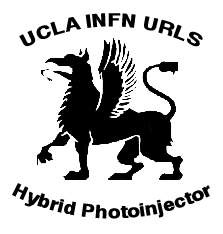
To begin the design process a suitable traveling wave accelerator was needed. An X-Band TW system was adapted to our needs through conversion to S-Band and the addition of input and exit ports to allow coupling to the standing wave gun. Below is shown the Marinelli TW design scaled to S-Band. This step was quite straight forward as the iris design didn't need to be changed in the conversion from X to S Band.

Next the iris for the input into the SW gun and it's mirror opposite on the downstream end of the accelerating section were added, at which point the coupling iris had to be retuned to ensure proper phase advance per cell. The method used to tune the coupling iris involved creating three models with a cell added to each consecutive model. The phase advance was then plotted and the radius of the coupling cell and width of the input iris adjust slightly and systematically until the phase advance was deemed adequate.



Once the phase advance is as desired the whole system can be modeled from input port to exit (load) port. The results returned were similar to the animation above, with a few model changes, so they are not shown here. The next task was to tune the SW gun for addition to the TW section.
The next stop on the tour is the SW Gun Design.
This page is updated and maintained by Brendan O'Shea of the UCLA PBPL Lab.